Menu
Characterising and Understanding Trends and Variability in African Rainfall
Background
Precipitation in Africa has high societal importance, due to the large populations dependent upon agriculture for their source of subsistence and income. The timing of the rainy seasons and amount of rainfall is of high importance, not only for agriculture, but also via impacts on surface water supplies, energy supply from hydropower and the transmission of vector-borne diseases. Understanding the drivers and physical mechanisms behind African rainfall is important for interpreting current and future changes in timing and rainfall characteristics.Africa is acutely vulnerable to the effects of climate change so understanding future changes in the seasonal cycle of African precipitation is of utmost importance in establishing appropriate adaptation strategies. In order to achieve this, a few steps are required:
- Firstly, we require a method of quantifying the seasonality of precipitation. This has been achieved by developing a methodology for determining number of wet seasons experienced per year, and the onset and cessation dates for the wet season(s).
- Secondly, in order to produce future projections of seasonality we use climate model simulations. In order to produce reliable projections, we require that climate models have an accurate representation of current seasonality.
- Thirdly, we use projections from climate models to investigate future projections of onset and cessation.
Onset and Cessation Methodology
In order to look at large-scale shifts in the timing of the wet season and relate this to wider-scale drivers, the methodology for determing the onset and cessation of the wet season needs to be applicable across the entirety of continental Africa. Most previous methods for determining the onset focus on the national to regional scale, and are dependent on the exceedance of a certain threshold e.g. the first week with at least 20mm of rainfall, with one rainfall event of more than 10mm, and no dry spell of more than 10 days after the rain event for the next month. While such definitions work well at a national scale they are not applicable at a continental scale where rainfall amounts vary substantially.
The African continent also spans multiple climatic regimes; central African regions and the Horn of Africa experience two wet seasons per year, whereas West Africa, the Sahel and Southern Africa all experience one wet season per year. A method for determining the onset and cessation at the continental scale thus needs to account for regions with multiple wet seasons per year. We propose such a method, based on the method of Liebmann et al. (2012). The method has three steps:
- Firstly, determine the number of seasons experienced per year at the location (or grid point) of interest. This is achieved using harmonic analysis – the amplitude of the first and second harmonic were computed, and their ratio compared. If the ratio was greater than 1.0, i.e. the amplitude of the second harmonic was greater than the amplitude of the first harmonic then the grid point was defined as having two wet seasons per year (biannual), if the ratio was less than one then it was defined as having an annual regime. Figure 1 shows the ratio for one African rainfall dataset (TARCATv2). Three regions are identified as biannual regions; the Horn of Africa, an equatorial strip extending from Gabon to Uganda and a small region on the southern West African coastline.
- Secondly the period of the year when the wet season occurs was determined. This was achieved by looking for minima and maxima in the climatological cumulative daily rainfall anomaly to identify one or two seasons.
- The third and final stage is to calculate the onset and cessation dates for each year. This is done by looking for the minima and maxima in the cumulative daily rainfall anomaly, calculated for each season.

Figure 1: Location of regions with one and two seasons per year, determined using harmonic analysis. Yellow indicates two seasons per year, while pink/purple indicates one season per year. Computed from TARCATv2 data.
Figure 2 shows the seasonal progression of the onset and cessation, with the patterns observed in agreement with those expected from the driving physical mechanisms, and continuous progression across the annual/biannual boundaries. Over West Africa and the Sahel, Figure 2a-b shows zonally-contiguous progression patterns with onset following the onset of the long rains and moving north, and cessation moving southward, preceding the end of the short rains. Over southern Africa Figure 2c-d shows the onset over southern Africa starting in the north-west and south-east, following the onset of the short rains, reaching the East African coast last, and cessation starting at the Zimbabwe, Mozambique, South Africa border and spreading out radially into the cessation of the long rains.
As well as testing the method for compatibility with known physical drivers of African rainfall, agreement across multiple satellite-based rainfall estimates was also examined. In general, good agreement was found across the datasets, particularly for regions with an annual regime and over the biannual region of East Africa.
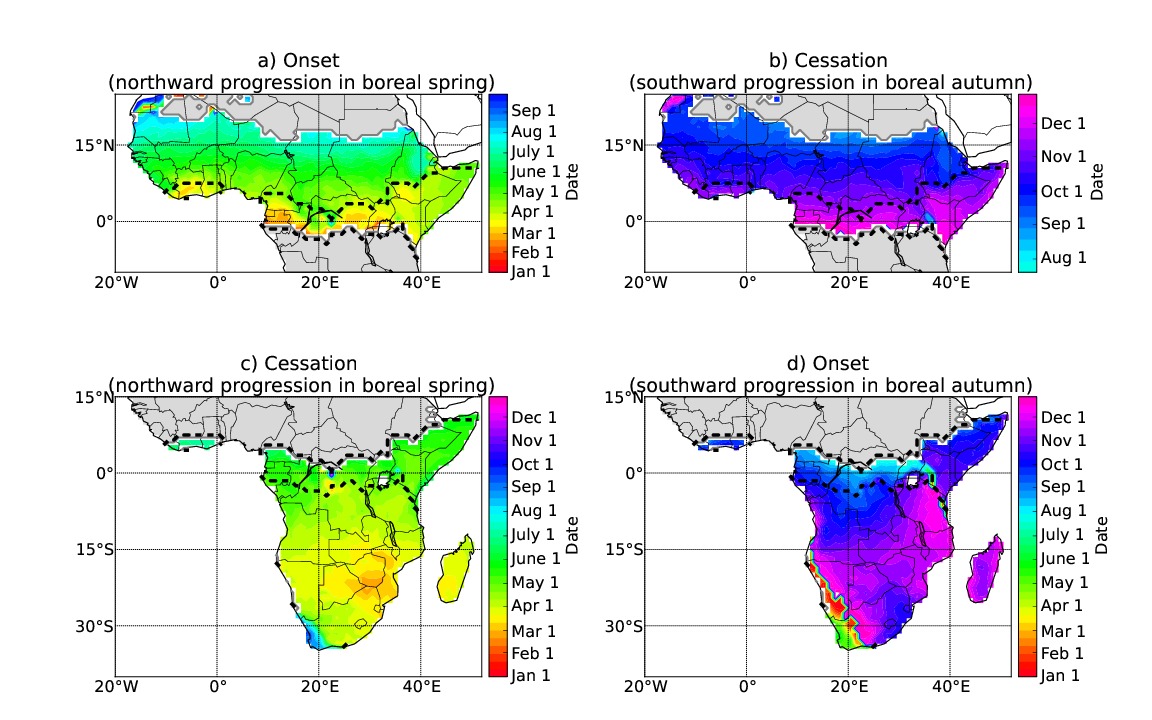
Figure 2: Southward and northward progression of the onset and cessation across the annual/biannual boundaries, computed using GPCP daily rainfall data 1998-2013.
For more details, please see the paper detailing this work: Dunning, C.M., E Black, and R.P. Allan (2016) The onset and cessation of seasonal rainfall over Africa, Journal of Geophysical Research: Atmospheres, 121 11,405-11,424, doi: 10.1002/2016JD025428
Representation of the seasonal cycle in climate model simulations
The second stage is to establish how well climate model simulations represent the current seasonal cycle of precipitation over Africa. Two sets of simulations from the CMIP5 generation of models were examined:- 28 atmosphere-only (AMIP) simulations, which applies observed sea surface temperature (SST) and sea ice
- 39 coupled (CMIP5 historical) simulations, which includes a fully coupled ocean and is driven by historical radiative forcings.
It was found that rainy seasons are differentiated more clearly from the dry seasons when the seasons are determined dynamically, as the method accounts for interannual variability in seasonal timing and model timing biases (Figure 3).
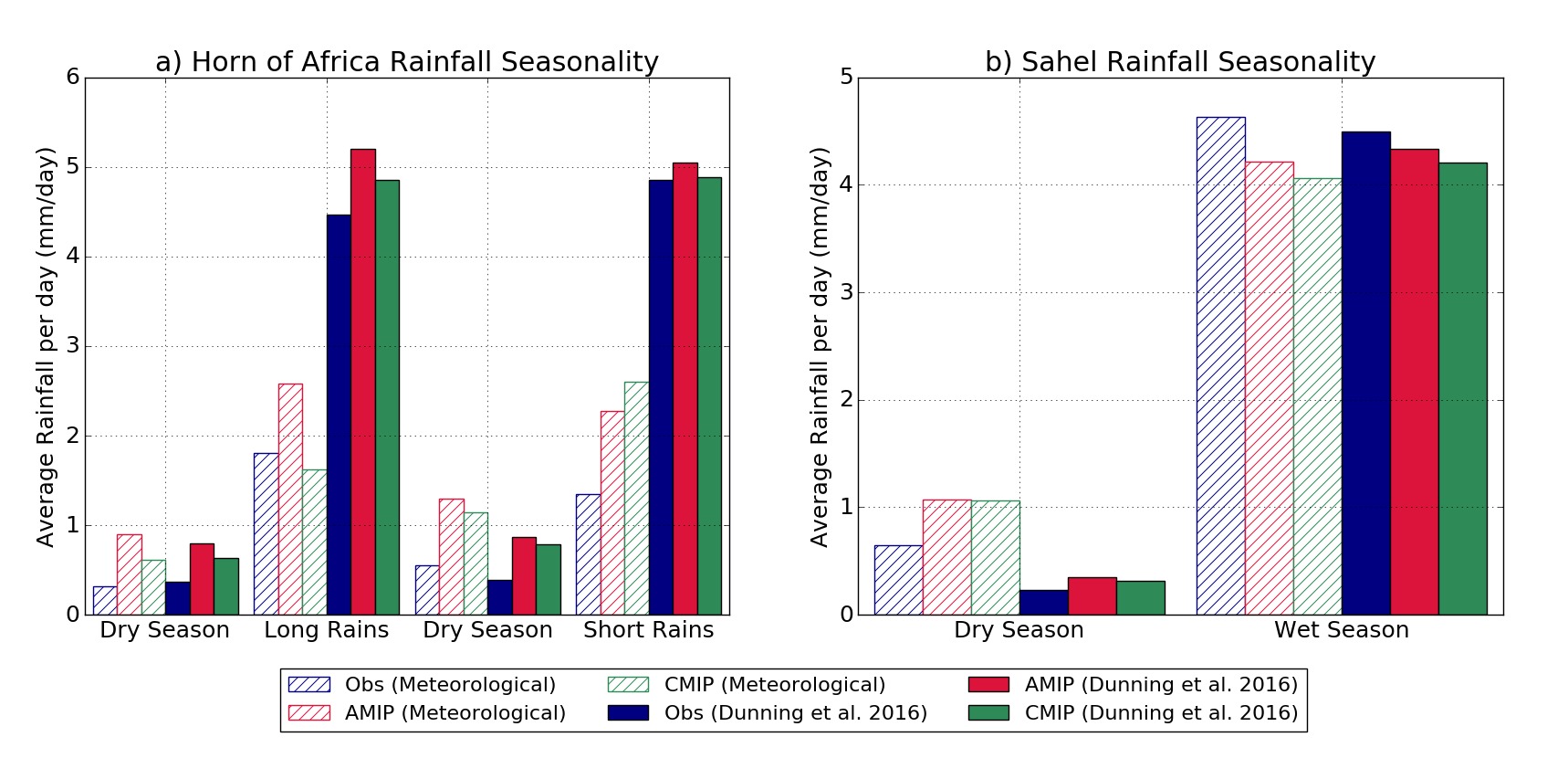
Figure 3: Average rainfall rate (mm/day) during the wet/dry seasons over the Horn of Africa (a) and sahel (b) when defined using meteorological seasons (dashed bars) and dynamically varying seasons (Dunning et al., 2016, solid). The same set of simulations was used for both meteorological and dynamically varying seasons.
Seasonal timing in model simulations demonstrates good agreement with observations (Figure 4), although both sets of simulations exhibit an early onset over the Sahel (~25 days early), and coupled simulations exhibit timing biases over the Horn of Africa (long rains ~20 days late).
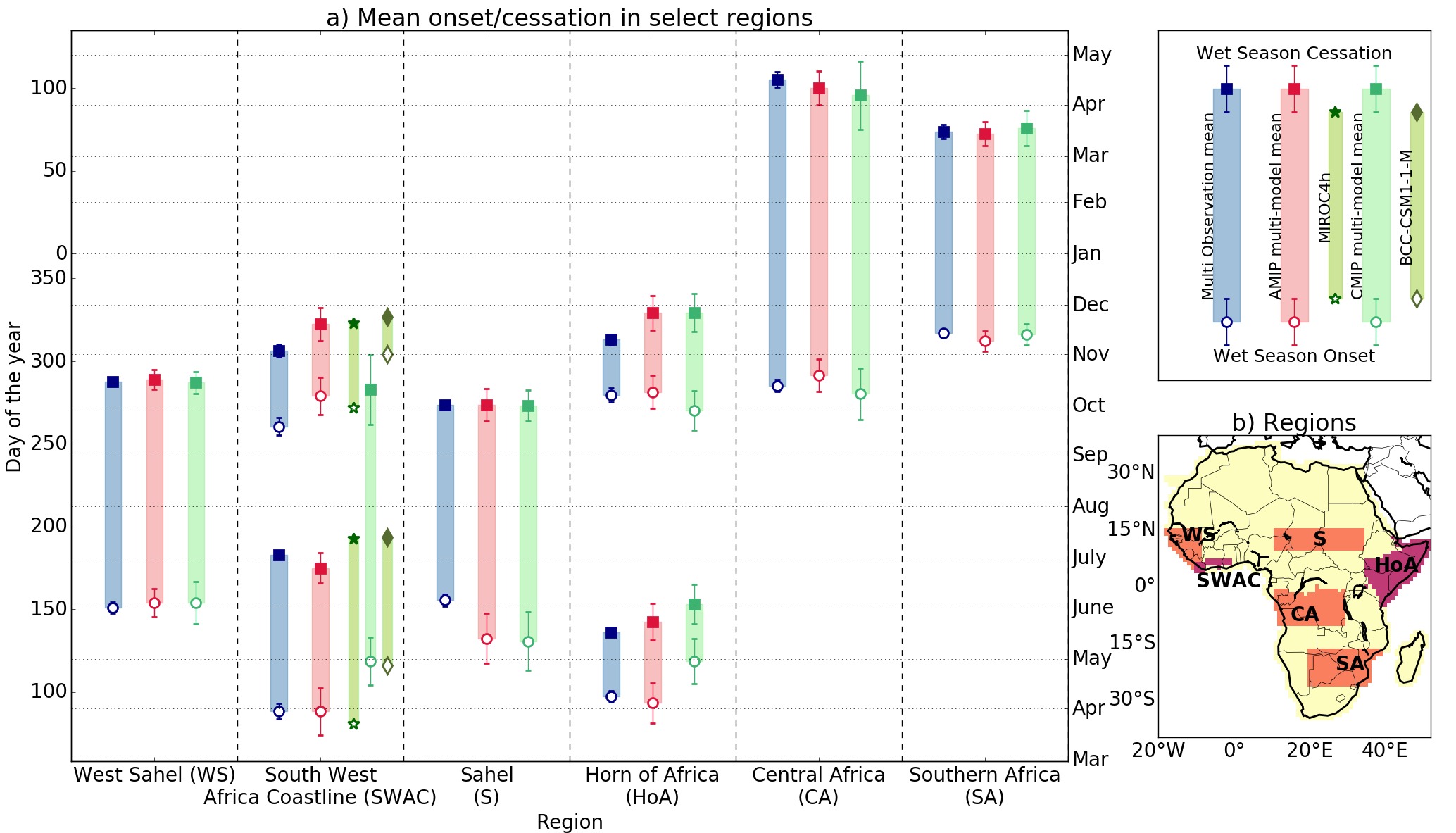
Figure 4: Multi-model mean onset (open circles) and cessation (filled squares) for observations, atmosphere-only (AMIP) and coupled (CMIP) over selected regions (b). Shaded bars indicate the period of the wet season. For SWAC the mean annual regime onset/cessation in coupled simulations is plotted, along with mean onset/cessation for MIROC4h and BCC-CSM1-1-M (coupled simulations).
Over the southern West African coastline satellite-based precipitation estimates show two wet seasons in April-June and September-October, separated by a Little Dry Season (LDS, Figure 5). While atmosphere-only simulations correctly capture the seasonal cycle here, coupled simulations fail to capture the LDS (Figure 5b). Previous studies have suggested an SST driver for the LDS. The coupled simulations used in this study were found to contain an unrealistic seasonal cycle of SST in northern Gulf of Guinea, and erroneous SST/rainfall relationships, which is proposed as the cause of this discrepancy, with further investigation required.
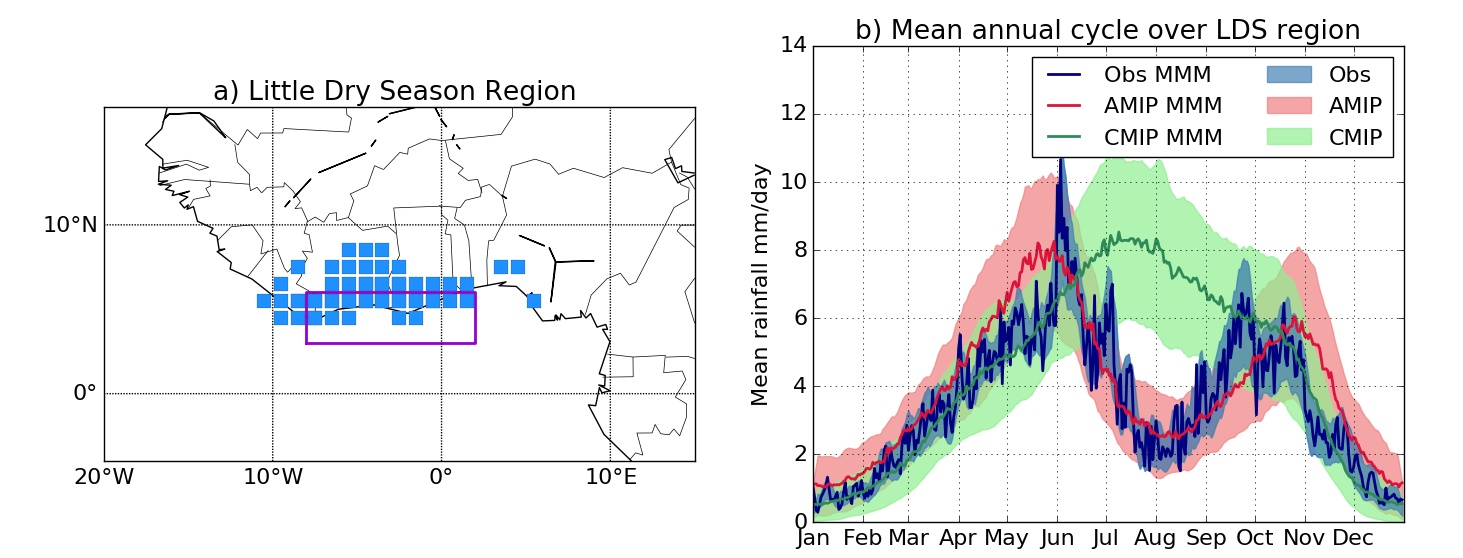
Figure 5: a) Location of the region that experiences the Little Dry Season (LDS; blue dots) and the SST region of interest (pink box). b) Mean annual cycle of rainfall in observations, atmosphere-only and coupled simulations over LDS region.
The full paper detailing this work can be found here:
Dunning, C.M., Allan, R.P. and Black, E. (2017) Identification of deficiencies in seasonal rainfall simulated by CMIP5 climate models, Environmental Research Letters, 12(11), 114001, doi:10.1088/1748-9326/aa869e
Future Projections of Seasonality
The final stage of the project was to assess how wet seasons across Africa may change under future climate change. The fourth IPCC (Intergovernmental Panel on Climate Change) Assessment Report states that “Africa is one of the most vulnerable continents to climate change and climate variability”. This is partly related to low adaptive capacity across much of the continent but is also related to the high dependence on climate, in particular wet season rainfall. Thus it was important to assess how characteristics of wet seasons may change across Africa under future climate change.
The methodology detailed above was applied to Coupled Model Intercomparison Project Phase 5 (CMIP5) model simulations to produce onset and cessations dates for present (1980-1999) and future (2080-2099) periods. Two future scenarios were used; RCP 4.5 is a medium emissions scenario, while RCP 8.5 is a high emissions scenario.
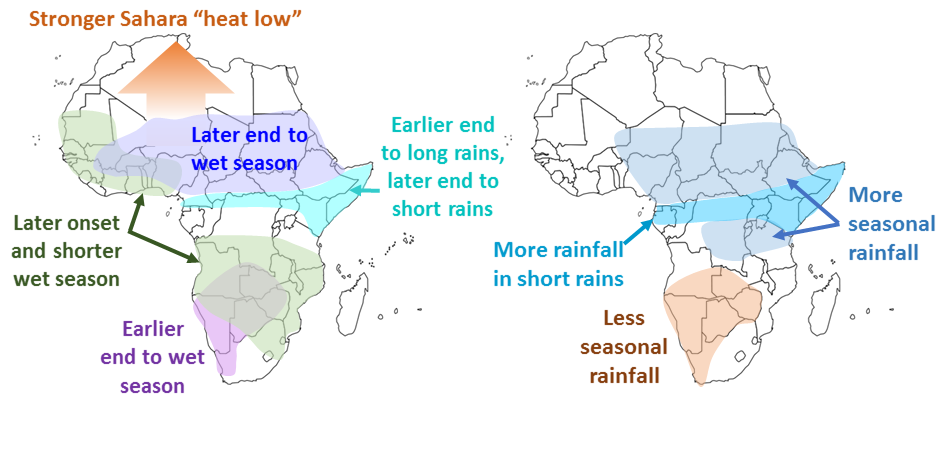
Figure 6: Schematic showing changes in timing of the wet season (left) and changes in seasonal rainfall totals (right).
The projections show a delay in the onset of the wet season across much of western and southern Africa under future climate change. In regions where there is little change in the end date (‘cessation’, e.g. western Africa) or regions where the end of the wet season gets earlier (e.g. southern Africa) a later onset means the wet season shortens. This may be problematic for crops, as a shorter wet season can lead to a shorter growing season and result in crops not reaching full maturity.
Across much of central Africa projections suggest that the amount of rainfall occurring during the wet season will increase. However, over southern Africa projections show lower rainfall totals. In such regions agricultural adaptation (e.g. to alternative crop varieties) may be required.
The Horn of Africa (Somalia, southern Ethiopia, Kenya and Uganda) and equatorial regions experience two wet seasons per year; one in the Northern Hemisphere spring (known as the long rains) and one in the autumn (known as the short rains). Our results show the long rains ending earlier, and the short rains ending later. The most notable result, however, is the large increase in the amount of rainfall occurring during the short rains. We linked these changes in timing of the progression of the seasonal rainfall with changes in the summer heat low over the Saharan Desert (see paper for full details).
Another important finding is that within the wet season rainfall intensity will increase, whilst frequency will decrease; heavier rainfall is damaging to crops with delicate flowers such as coffee and cocoa. In addition, long dry periods can reduce soil moisture and harden the surface layer; thus, when heavy rainfall events do occur a smaller fraction infiltrates into the soil and increased runoff leads to soil erosion and flooding.
Overall, we found that future climate change will lead to changes in the timing of wet seasons over Africa, with shorter wet seasons over southern Africa. Seasonal rainfall totals are projected to increase over central regions, but decrease over southern Africa. Suitable adaptation may be required; for example, using crop varieties that can cope with a shorter growing season or altering farming practices to minimise soil erosion. Other adaptation may be required to protect crops from increasing intensity of rainfall.
The full paper detailing the results can be found here:
Dunning, C.M., Black, E. and Allan, R.P. (2018) Later Wet Seasons with More Intense Rainfall over Africa under Future Climate Change, Journal of Climate, 31, 9719–9738, doi:10.1175/JCLI-D-18-0102.1
The press release on the paper can be found here.